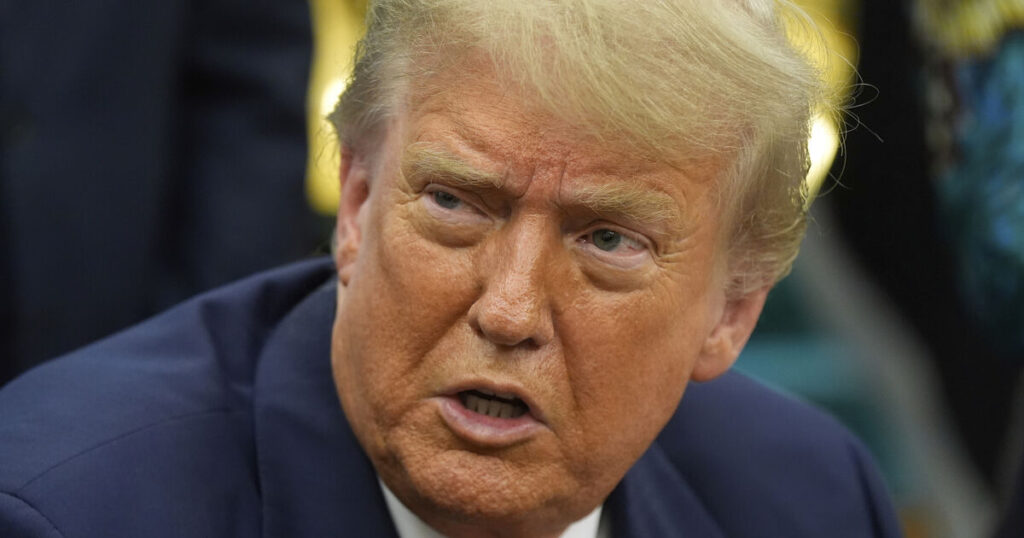US President Donald Trump has announced the suspension of trade negotiations with Canada, citing the country’s planned digital services tax as “a direct and blatant attack on our country.”
In a post on his social media platform, Truth Social, Mr. Trump stated that Canada had confirmed its intent to proceed with the tax, which targets both Canadian and foreign businesses that engage with online users in Canada. The tax is scheduled to take effect on Monday.
“Based on this egregious Tax, we are hereby terminating ALL discussions on Trade with Canada, effective immediately. We will let Canada know the Tariff that they will be paying to do business with the United States of America within the next seven day period,” Mr Trump stated.
This announcement marks the latest in a series of trade actions initiated by Mr. Trump since assuming office for a second term in January.
Relations with Canada have been turbulent, marked by the US president’s previous suggestions of potential US state absorption plans .
Canadian Prime Minister Mark Carney responded on Friday, stating that his government would “continue to conduct these complex negotiations in the best interests of Canadians. It’s a negotiation”.
Mr. Trump later expressed his expectation that Canada would repeal the tax.
“Economically we have such power over Canada. We’d rather not use it,” Mr. Trump said in the Oval Office. “It’s not going to work out well for Canada. They were foolish to do it.”
When questioned about potential avenues for restarting talks, he suggested Canada could eliminate the tax, predicting it would while adding: “It doesn’t matter to me.”
Mr. Carney had previously visited Mr. Trump at the White House in May. Mr. Trump’s recent trip to Canada for the G7 summit in Alberta saw Mr. Carney state that Canada and the US had established a 30-day deadline for trade discussions.
The digital services tax, set at a 3% levy on revenue from Canadian users, will affect companies such as Amazon, Google, Meta, Uber, and Airbnb. The tax will be applied retroactively, potentially resulting in a $2 billion USD (£1.4 billion) bill for US companies due at the end of the month.
“We appreciate the Administration’s decisive response to Canada’s discriminatory tax on US digital exports,” stated Matt Schruers, chief executive of the Computer & Communications Industry Association.
Canada and the US have been engaged in discussions on easing tariffs imposed by Mr. Trump on goods from its neighbor.
The Republican president previously indicated that the US would soon issue letters to various countries, detailing the new tariff rates to be imposed by his administration.
Mr. Trump has already implemented 50% tariffs on steel and aluminum, as well as 25% tariffs on cars. He also levies a 10% tax on imports from most countries, with potential rate increases on July 9, following the expiration of the 90-day negotiating period.
Canada and Mexico face separate tariffs, up to 25%, instituted by Mr. Trump under the pretense of curbing fentanyl smuggling, though exemptions do exist under the 2020 US-Mexico-Canada Agreement agreed during Mr. Trump’s initial term.
Following a private meeting with Republican senators on Friday, Treasury Secretary Scott Bessent declined to comment on the news that Mr. Trump had terminated trade discussions with Canada .
“I was in the meeting,” Mr. Bessent said, before proceeding to the next question.
80%
Proportion of Canada’s exports that go to the US
Approximately 60% of US crude oil imports originate from Canada, along with 85% of US electricity imports.
Canada remains the largest foreign supplier of steel, aluminum and uranium to the US and possesses 34 critical mineral/metals identified by the Pentagon as valuable.
Roughly 80% of Canada’s exports are directed towards the US.
Daniel Beland, a political science professor at McGill University noted that it is a domestic tax issue, that has been a tension point between Canada and US because it targets US tech companies.
“The Digital Services Tax Act was signed into law a year ago so the advent of this new tax has been known for a long time,” Mr. Beland said. “Yet, President Trump waited just before its implementation to create drama over it in the context of ongoing and highly uncertain trade negotiations between the two countries.”


